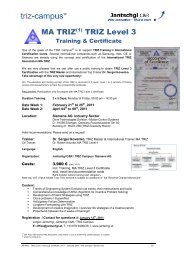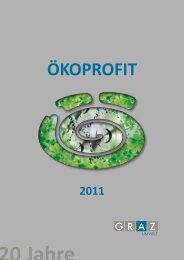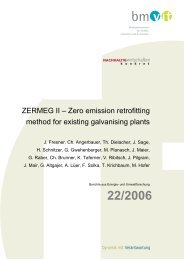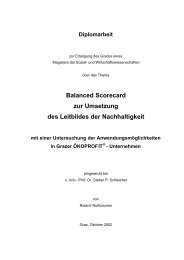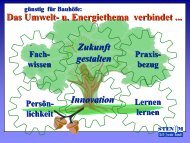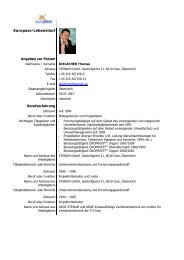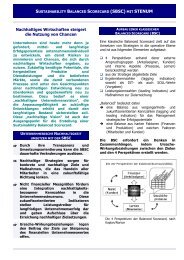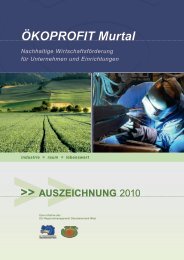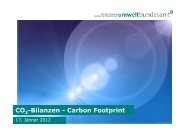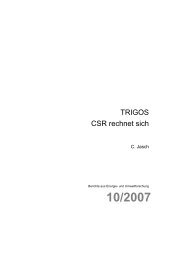Promoting Resource Efficiency in Small & Medium size ... - UNEP
Promoting Resource Efficiency in Small & Medium size ... - UNEP
Promoting Resource Efficiency in Small & Medium size ... - UNEP
You also want an ePaper? Increase the reach of your titles
YUMPU automatically turns print PDFs into web optimized ePapers that Google loves.
Type of mill<br />
Integrated mach<strong>in</strong>e f<strong>in</strong>ished newspr<strong>in</strong>t (100% TMP (thermo mechanical<br />
pulp))<br />
Process heat consumption (net) <strong>in</strong><br />
GJ/ADt 1<br />
- 1.3 2 2.2<br />
Integrated magaz<strong>in</strong>e paper (100% TMP) - 0.3 2 2.1<br />
Integrated newspr<strong>in</strong>t (> 50% mechanical pulp) 0 – 3.0 2.0 – 3.0<br />
Integrated lightweight coated paper (LWC) mill (> 50% mechanical pulp) 3.0 – 12.0 1.7 – 2.6<br />
Integrated super calendared (SC) mill (> 50% mechanical pulp) 1.0 – 6.0 1.9 – 2.6<br />
Integrated cardboard (> 50% mechanical pulp) 3.5 – 13.0 2.3 – 2.8<br />
Non-<strong>in</strong>tegrated chemical thermo mechanical pulp 0 2.0 – 3.0<br />
Table 30: Heat and power consumption <strong>in</strong> paper-mak<strong>in</strong>g by product<br />
Power consumption (net) <strong>in</strong> MWh/ADt<br />
Explanatory notes: (-) <strong>in</strong>dicates surplus<br />
The units can be converted from MWh to GJ accord<strong>in</strong>g to 1 MWh = 3.6 GJ and 1 GJ = 0.277 MWh<br />
Data from [J. Pöyry, 1998], [SEPA Report 4712-4, 1997], [F<strong>in</strong>nish BAT Report, 1997]<br />
1) The net process heat consumption depends ma<strong>in</strong>ly on the type of ref<strong>in</strong><strong>in</strong>g and the degree of heat recovery<br />
2) The values can only be reached if heat recovery, paper mach<strong>in</strong>e press section and the use of electricity are all implemented and operated <strong>in</strong> an ideal way. In<br />
exist<strong>in</strong>g processes this is rarely the case.<br />
Table 31 gives benchmarks for the energy consumption for different<br />
production steps for paper mills.<br />
Department Process heat [MJ/t] Electric power [kWh/t]<br />
Wood handl<strong>in</strong>g 150 50<br />
Ref<strong>in</strong><strong>in</strong>g 0 21101)<br />
Wash<strong>in</strong>g and screen<strong>in</strong>g 0 50<br />
Bleach<strong>in</strong>g 0 75<br />
Bleach chemical preparation 0 5<br />
Bleached stock screen<strong>in</strong>g 0 35<br />
Power boiler 0 25<br />
Total pulp mill 150 2350<br />
Stock preparation 0 235<br />
Paper mach<strong>in</strong>e 5300 1) 2) 350<br />
Total paper mill 5300 585<br />
Effluent treatment 0 39<br />
Total per tonne of paper 5450 2974<br />
Table 31: Energy consumption for different production steps for paper mills<br />
Notes:<br />
1) A F<strong>in</strong>nish <strong>in</strong>tegrated TMP mill higher electricity consumption <strong>in</strong> the range of 2400 kWh/t was reported for the ref<strong>in</strong><strong>in</strong>g stage (<strong>in</strong>clud<strong>in</strong>g reject ref<strong>in</strong><strong>in</strong>g) and a<br />
lower value of 4800 MJ/t process heat consumption for the paper mach<strong>in</strong>e respectively [F<strong>in</strong>nish comments].<br />
2) A Swedish newspr<strong>in</strong>t mill reports a heat demand of about 4 GJ/t for dry<strong>in</strong>g paper, a need that will be reduced by about 10% with a future shoe-press <strong>in</strong>stallation.<br />
94



